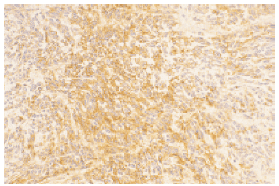Lemosol / Lemosol A
In dehydrated tissue, water is replaced by alcohol, but alcohol is not compatible with paraffin. Therefore, the alcohol in the tissue must be replaced by an intermediate agent that is compatible with paraffin.
One of the intermediate agents now widely used is xylene, which is compatible with both alcohol and paraffin. However, xylene is highly volatile, has a pungent odor, and is harmful to the human body; these properties have been a problem in the work environment. Lemosol and Lemosol A can be used as substitute for xylene and have almost no toxicity or pungency.
In particular, Lemosol A is an intermediate agent whose main ingredient is a phytoncide (a compound that has a refreshing scent and is considered to have a forest bathing effect). Features of each product are shown below.
| Lemosol | Lemosol A (Ace) | |
|---|---|---|
| Principal component | D(+)-Limonene | Pinene compound |
| Source | Orange peel | Eucalyptus, pine bark |
| Odor | Citrus scent | Scent like eucalyptus leaves and pine resin |
| Volatility | Less volatile than xylene | Excellent volatility (equivalent to xylene) |
| Specific gravity (20°C) | 0.838~0.844 g/mL | 0.873~0.879 g/mL |
| Flash point | 61 ℃ | 36.5 ℃ |
| Boiling point | 177 ℃(d-limonene) | 154 ℃~166 ℃ |
| Refractive index (20°C) | 1.473 | 1.475 |
| Toxicity (LD50, rat, oral) | ≥ 5 g/kg | ≥ 5 g/kg |
| Notes | Non-irritant to the eyes, nose, throat, and skin. Limonene is approved by the U.S. FDA as a food additive and flavor ingredient. |
Non-irritant to the eyes, nose, throat, and skin. Pinene is approved by the U.S. FDA as a food additive and flavor ingredient. |
Lemosol
Lemosol is a low-toxicity substitute solvent for xylene and chloroform. The main ingredient of this product is D(+)-limonene, a component of orange peel oil that has a slight lemon scent.
Features
- Safe and low-toxicity solvent
- Can be used as an intermediate, deparaffinizing, and clearing agent, in place of xylene and chloroform
- Paraffin-embedded tissue sections can be prepared while maintaining the softness of the organ, even when xylene used as an intermediate agent would cause shrinkage and hardening of the tissue and make it difficult to cut thin sections
- Easier disposal of waste liquids; decomposed by microorganisms, unlike xylene
- Can be used in general and immunohistochemical staining
- Principal component is purified limonene, which has a mild citrus scent
Example of tissue section staining performed using Lemosol
-
Human stomach (biopsy) 
H&E staining -
Human lung (CEA) 
ABC staining
Lemosol A (Ace)
Lemosol A (Ace) is a terpene solvent mainly composed of plant extracts from eucalyptus and pine bark. This product is a substitute for xylene and can be used as an intermediate and clearing agent in the preparation of histopathological specimens. Lemosol A has no solvent odor but is highly volatile; its performance is even better than that of Lemosol.
Features
- Excellent volatility (almost equivalent to that of xylene)
- Non-irritant to the eyes, nose, throat, and skin; safe, with no toxicity, unlike xylene
- Can be used for H&E, special and immunohistochemical staining
- Used liquid can be solidified; easier disposal
Example of a procedure using this as an intermediate agent
Conditions for deparaffinization and alcohol treatment
Conditions for clearing and encapsulation
- * When this product is mixed with ethanol or water, it may become turbid or precipitate. If turbidity or precipitation is observed, we recommend immersion of the glass slides in a mixture of this product and 100% ethanol (1:1 ratio), before moving the slides from this product to ethanol or vice versa.
How to dispose of Lemosol and Lemosol A
- Solidifying agent is available.
- When disposing of these products as used liquid, treat the liquid with activated sludge or perform other appropriate treatment before discharging it, because direct discharge into drains leading to public rivers may cause an increase in biochemical oxygen demand (BOD) and total organic carbon (TOC).
Lemosol Coagulant
This product is a solidifying agent for used liquid Lemosol and Lemosol A, intermediate/clearing agents used in the preparation of pathological specimens.
Principal component
Castor-derived hydrogenated fatty acid
Procedure
- Add this product to waste liquid Lemosol or Lemosol A (approximately 5%).
- Stir and dissolve; heat the solution to about 60°C using a hot stirrer or a water bath. (beware of fire)
- Allow the solution to cool and solidify
Warning
- Lemosol and Lemosol A are highly flammable solvents. Do not heat over an open flame or use near a fire.
- Handling after solidification: Handle the solidified waste as a hazardous material in accordance with applicable laws and regulations.
- The disposal method described above is not applicable to liquid waste contaminated with xylene or formalin.
Indoor storage for some period of time after solidification
Put solidified waste in a plastic bag or other containers, making sure to tie the mouth of the bag to prevent leakage, and keep it away from fire.
(The waste liquid vaporizes easily, especially during the summer, and unless it is sealed, it may catch fire if brought close to a flame.)
Product List
- Open All
- Close All
For research use or further manufacturing use only. Not for use in diagnostic procedures.
Product content may differ from the actual image due to minor specification changes etc.
If the revision of product standards and packaging standards has been made, there is a case where the actual product specifications and images are different.



